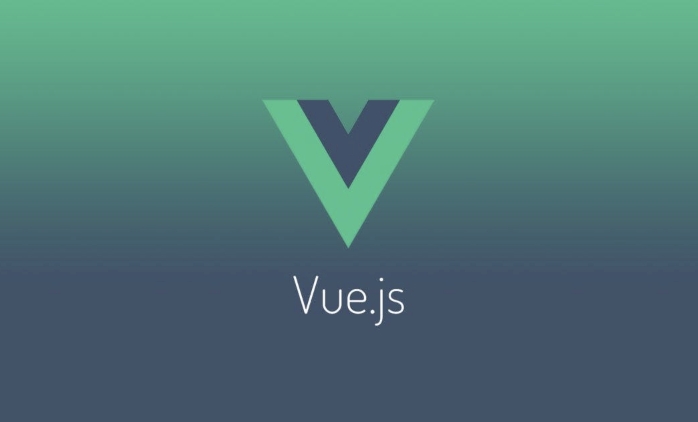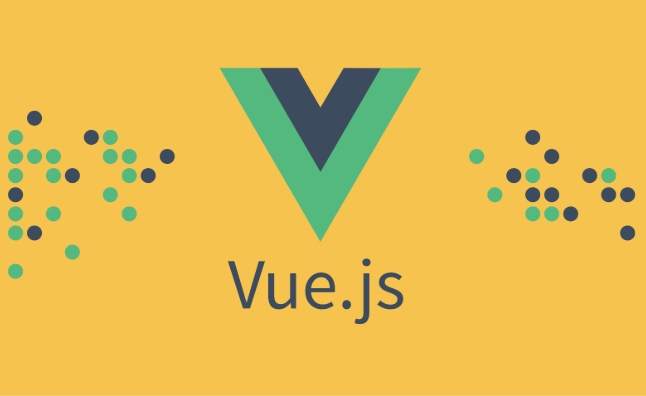The defineModel macro solves the redundant code problem when custom components implement v-model in Vue 3.4. 1. It automatically creates modelValue prop and update:modelValue events in <script setup>. 2. Supports custom attribute names and event names through parameters, 3. It can pass options such as types and default values. 4. As a compile-time macro, eliminates runtime overhead, 5. Makes the two-way binding of parent-child components more concise and efficient, and ultimately achieves less code, the same behavior, and clearer intentions.

The defineModel macro in Vue 3.4 is a compiler macro that simplifies two-way binding (v-model) in custom components by automatically creating a modelValue prop and an update:modelValue event — or a custom prop/event pair — with minimal boilerplate.

It was introduced in Vue 3.4 as a syntax sugar to make writing v-model-compatible components much cleaner, especially in <script setup></script> .
? What problem does it solve?
Before defineModel , if you wanted to support v-model in a component, you had to manually define:

<script setup> defineProps(['modelValue']) defineEmits(['update:modelValue']) </script>
Then bind it in the template:
<input :value="modelValue" @input="$emit('update:modelValue', $event.target.value)" >
This is repetitive and verbose.

? How defineModel works
With defineModel , Vue automatically generates the prop and emit declaration:
<script setup> const modelValue = defineModel() </script> <template> <input v-model="modelValue"> </template>
This single line replaces both the prop and emit definition.
Under the hood, it's equivalent to:
defineProps(['modelValue']) defineEmits(['update:modelValue'])
But now you can directly read and write modelValue like a ref.
? Customizing the model
You can also use a custom prop name and event using arguments:
<script setup>
const checked = defineModel('checked', { type: Boolean })
</script>
<template>
<input type="checkbox" v-model="checked">
</template>This creates:
- A prop named
checked - An event named
update:checked
You can even pass options like type , required , etc., just like with defineProps .
const count = defineModel('count', {
type: Number,
default: 0
})?? Important Notes
-
defineModelis only available inside<script setup>. - It's a compiler macro , so it doesn't exist at runtime. It gets compiled away during build.
- It only works in SFCs (Single File Components) with build tool support (eg, Vite, Vue CLI).
- Not available in plain JavaScript or runtime-rendered components.
? Two-way binding made easy
Now parent usage stays the same:
<ChildComponent v-model="searchText" />
And the child handles it with zero boilerplate.
Summary
defineModel in Vue 3.4:
- Reduces boilerplate for
v-modelsupport - Acts as a ref-like value that syncs with the parent
- Supports custom names and type options
- Is a compile-time helper (no runtime cost)
It's a small but powerful quality-of-life improvement for component authors.
Basically: less code, same behavior, cleaner intent.
The above is the detailed content of What is the defineModel macro in Vue 3.4?. For more information, please follow other related articles on the PHP Chinese website!

Hot AI Tools

Undress AI Tool
Undress images for free

Undresser.AI Undress
AI-powered app for creating realistic nude photos

AI Clothes Remover
Online AI tool for removing clothes from photos.

Clothoff.io
AI clothes remover

Video Face Swap
Swap faces in any video effortlessly with our completely free AI face swap tool!

Hot Article

Hot Tools

Notepad++7.3.1
Easy-to-use and free code editor

SublimeText3 Chinese version
Chinese version, very easy to use

Zend Studio 13.0.1
Powerful PHP integrated development environment

Dreamweaver CS6
Visual web development tools

SublimeText3 Mac version
God-level code editing software (SublimeText3)
 What is headless UI in Vue?
Jul 08, 2025 am 01:38 AM
What is headless UI in Vue?
Jul 08, 2025 am 01:38 AM
HeadlessUIinVue refers to a library of UI components that provide no preset styles and only contains core logic and behavior. Its features include: 1. No style restrictions, developers can customize the design; 2. Focus on barrier-free and interactive logic, such as keyboard navigation, state management, etc.; 3. Support Vue framework integration, exposing the control interface through combinable functions or components. Reasons for use include: maintaining design consistency, built-in accessibility, strong component reusability, and lightweight library size. In practical applications, developers need to write HTML and CSS themselves. For example, when building a drop-down menu, the library handles state and interaction, while developers decide on visual presentation. Mainstream libraries include HeadlessUI and RadixVue for TailwindLabs, suitable for
 How to watch nested properties in Vue 3?
Jul 07, 2025 am 12:51 AM
How to watch nested properties in Vue 3?
Jul 07, 2025 am 12:51 AM
In Vue3, there are three ways to monitor nested properties using the watch function: 1. Use the getter function to accurately monitor specific nested paths, such as watch(()=>someObject.nested.property,callback); 2. Add the {deep:true} option to deeply monitor changes within the entire object, which is suitable for situations where the structure is complex and does not care about which property changes; 3. Return an array in the getter to listen to multiple nested values ??at the same time, which can be used in combination with deep:true; in addition, if ref is used, the nested properties in its .value need to be tracked through getter.
 How to build a component library with Vue?
Jul 10, 2025 pm 12:14 PM
How to build a component library with Vue?
Jul 10, 2025 pm 12:14 PM
Building a Vue component library requires designing the structure around the business scenario and following the complete process of development, testing and release. 1. The structural design should be classified according to functional modules, including basic components, layout components and business components; 2. Use SCSS or CSS variables to unify the theme and style; 3. Unify the naming specifications and introduce ESLint and Prettier to ensure the consistent code style; 4. Display the usage of components on the supporting document site; 5. Use Vite and other tools to package as NPM packages and configure rollupOptions; 6. Follow the semver specification to manage versions and changelogs when publishing.
 Key differences between Vue 2 and Vue 3?
Jul 09, 2025 am 01:29 AM
Key differences between Vue 2 and Vue 3?
Jul 09, 2025 am 01:29 AM
Vue3 has improved in many key aspects compared to Vue2. 1.Composition API provides a more flexible logical organization method, allowing centralized management of related logic, while still supporting Vue2's Options API; 2. Better performance and smaller package size, the core library is reduced by about 30%, the rendering speed is faster and supports better tree shake optimization; 3. The responsive system uses ES6Proxy to solve the problem of unable to automatically track attribute addition and deletion in Vue2, making the responsive mechanism more natural and consistent; 4. Built-in better support for TypeScript, support multiple node fragments and custom renderer API, improving flexibility and future adaptability. Overall, Vue3 is a smooth upgrade to Vue2,
 How to create a Vue 3 project with Vite?
Jul 05, 2025 am 01:39 AM
How to create a Vue 3 project with Vite?
Jul 05, 2025 am 01:39 AM
It is recommended to use Vite to create Vue3 projects because it uses the browser's native ES module support and has a fast startup speed in development mode. 1. Make sure to install Node.js (16.x or higher) and npm/yarn/pnpm; 2. Run npmcreatevite@latestmy-vue-app--templatevue initialization project; 3. Follow the prompts to select TypeScript, VueRouter and other configurations; 4. Execute cdmy-vue-app and npminstall installation dependencies; 5. Use npmrundev to start the development server. Optional configurations include automatic browser opening, proxy settings, alias paths, and packaging optimizations. Recommended insurance
 How to define routes in vue router?
Jul 05, 2025 am 12:58 AM
How to define routes in vue router?
Jul 05, 2025 am 12:58 AM
Defining routes in Vue projects requires understanding the structure and configuration. The steps are as follows: 1. Install and introduce vue-router, create a routing instance, and pass in a routes array containing path and component; 2. Use dynamic routing matching such as /user/:id to obtain parameters; 3. Use children attribute to implement nested routes; 4. Name the routes with the name attribute for jumping; 5. Use redirect for path redirect. After mastering these core points, you can configure routing efficiently.
 Benefits of using ?
Jul 08, 2025 am 12:20 AM
Benefits of using ?
Jul 08, 2025 am 12:20 AM
? in regular expressions are used to convert greedy matches to non-greedy, achieving more accurate matches. 1. It makes the content as little as possible to match as little as possible to avoid mismatch across tags or fields; 2. It is often used in scenarios such as HTML parsing, log analysis, URL extraction, etc. that require precise control of the scope; 3. When using it, it is necessary to note that not all quantifiers are applicable. Some tools need to manually enable non-greedy mode, and complex structures need to be combined with grouping and assertions to ensure accuracy. Mastering this technique can significantly improve text processing efficiency.
 What is CORS and how does it affect Vue development?
Jul 07, 2025 am 12:11 AM
What is CORS and how does it affect Vue development?
Jul 07, 2025 am 12:11 AM
CORSissuesinVueoccurduetothebrowser'ssame-originpolicywhenthefrontendandbackenddomainsdiffer.Duringdevelopment,configureaproxyinvue.config.jstoredirectAPIrequeststhroughthedevserver.Inproduction,ensurethebackendsetsproperCORSheaders,allowingspecifico






